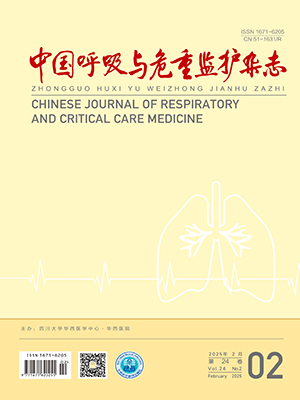| 1. |
Mudambi L, Miller R, Eapen GA. Malignant central airway obstruction. J Thorac Dis, 2017, 9(Suppl 10): S1087-S1110.
|
| 2. |
Williamson JP, Phillips MJ, Hillman DR, et al. Managing obstruction of the central airways. Intern Med J, 2010, 40(6): 399-410.
|
| 3. |
毛静宇, 胡蓓蓓, 茅秋霞, 等. 新型经支气管镜工作孔道释放的金属气道支架对恶性中央气道狭窄的治疗观察. 临床肺科杂志, 2020, 25(11): 1719-1722.
|
| 4. |
Ost DE, Shah AM, Lei X, et al. Respiratory infections increase the risk of granulation tissue formation following airway stenting in patients with malignant airway obstruction. Chest, 2012, 141(6): 1473-1481.
|
| 5. |
Vincent JL, Rello J, Marshall J, et al. International study of the prevalence and outcomes of infection in intensive care units. JAMA, 2009, 302(21): 2323-2329.
|
| 6. |
杨燕丽, 张秋玲, 杨璐, 等. 老年2型糖尿病患者隐匿性肺部感染病原学及其危险因素. 中华医院感染学杂志, 2021, 31(1): 1-5.
|
| 7. |
Wang Y, Li H, Chen B, et al. Pathogen distribution and drug resistance of nephrology patients with urinary tract infections. Saudi Pharm J, 2016, 24(3): 337-340.
|
| 8. |
金发光, 李时悦, 王洪武. 恶性中心气道狭窄经支气管镜介入诊疗专家共识. 中华肺部疾病杂志(电子版), 2017, 10(06): 647-654.
|
| 9. |
Agrafiotis M, Siempos II, Falagas ME. Infections related to airway stenting: a systematic review. Respiration, 2009, 78(1): 69-74.
|
| 10. |
中华医学会呼吸病学分会感染学组. 铜绿假单胞菌下呼吸道感染诊治专家共识. 中华结核和呼吸杂志, 2014, 37(1): 9-15.
|
| 11. |
王晓宁. 气道分泌物细菌培养联合药敏试验对下呼吸道感染抗菌药物合理使用的影响. 首都食品与医药, 2019, 26(18): 43.
|
| 12. |
杨帆. 《抗菌药物临床应用指导原则(2015年版)》解读. 中华临床感染病杂志, 2016, 9(5): 390-393.
|
| 13. |
刘卫, 谢红旗, 卓双塔. 气道支架置入术后相关肺部感染的病原学分析及抗感染策略. 中国医院药学杂志, 2019, 39(21): 2198-2200.
|
| 14. |
王辉, 吴宏成, 陈伟庄. 气道硅酮支架置入术后下呼吸道感染的临床特点及影响因素分析. 全科医学临床与教育, 2020, 18(4): 328-330,334.
|
| 15. |
Bender BS. Infectious disease risk in the elderly. Immunol Allergy Clin North Am, 2003, 23(1): 57-64.
|
| 16. |
Giamarellos-Bourboulis EJ, Tsilika M, Moorlag S, et al. Activate: randomized clinical trial of BCG vaccination against infection in the elderly. Cell, 2020, 183(2): 315-323.
|
| 17. |
Gibbs K, Collaco JM, McGrath-Morrow SA. Impact of tobacco smoke and nicotine exposure on lung development. Chest, 2016, 149(2): 552-561.
|
| 18. |
Duffney PF, Embong AK, McGuire CC, et al. Cigarette smoke increases susceptibility to infection in lung epithelial cells by upregulating caveolin-dependent endocytosis. PLoS One, 2020, 15(5): e0232102.
|
| 19. |
王辉, 叶彩虹, 马焕丽, 等. 吸烟介导的COPD呼吸道微生态失调对Treg/Th17失衡的影响. 分子诊断与治疗杂志, 2021, 13(3): 437-440,444.
|
| 20. |
陈智德, 柯明耀, 吴雪梅, 等. 硅酮支架与覆膜金属支架并发症的对比观察. 临床肺科杂志, 2016, 21(9): 1583-1586.
|
| 21. |
汤莹, 杜光. 我国雾化吸入疗法的临床应用现状及用药误区. 医药导报, 2019, 38(12): 1557-1561.
|
| 22. |
张洁莉, 邹珩, 张楠, 等. 金属和硅酮支架气道置入后引起支架相关呼吸道感染的发生率和病原学比较. 基础医学与临床, 2018, 38(3): 385-389.
|
| 23. |
Axelrad J, Kriplani A, Ozbek U, et al. Chemotherapy tolerance and oncologic outcomes in patients with colorectal cancer with and without inflammatory bowel disease. Clin Colorectal Cancer, 2017, 16(3): 205-210.
|
| 24. |
唐飞, 吕莉萍, 范晓云. 恶性中心气道狭窄患者气道支架置入术后近期疗效及远期存活时间的影响因素分析. 中国呼吸与危重监护杂志, 2021, 20(9): 643-648.
|
| 25. |
陶梅梅, 张楠, 邹珩, 等. 食管癌合并食管气管瘘患者气管支架置入前后肺部感染发生情况及病原学比较. 中华医学杂志, 2019, 99(10): 764-766.
|




